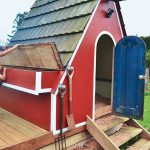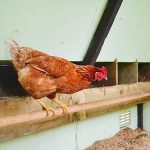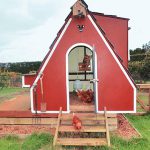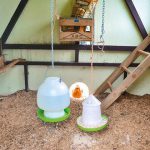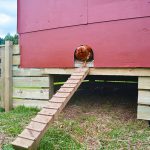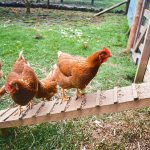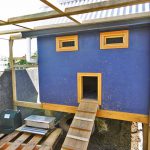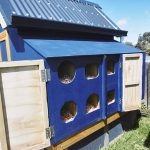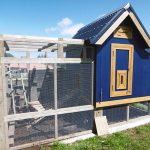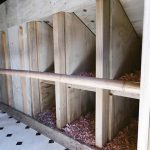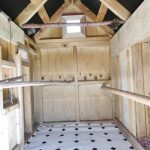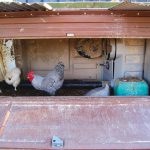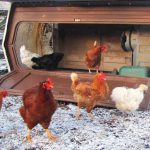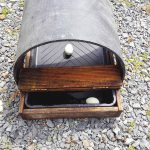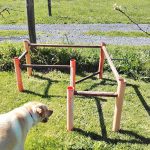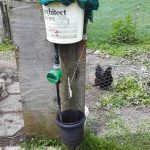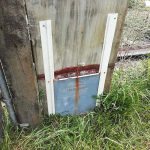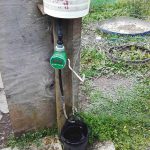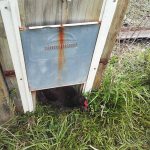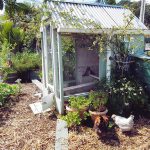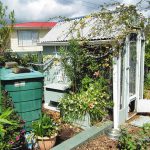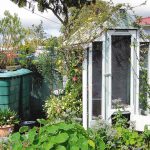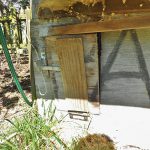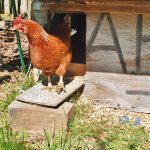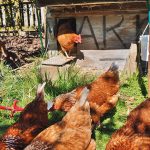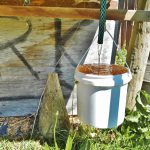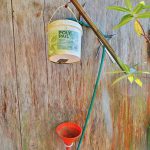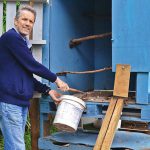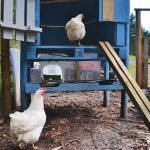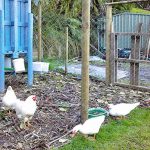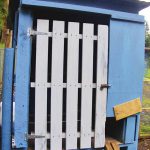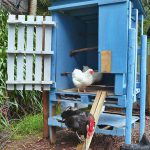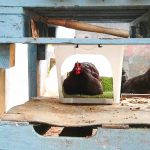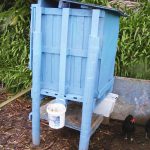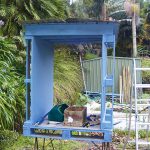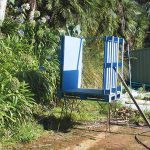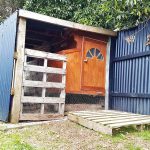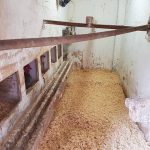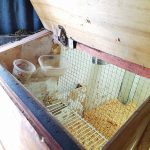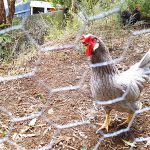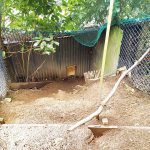10 New Zealanders share their DIY coop designs
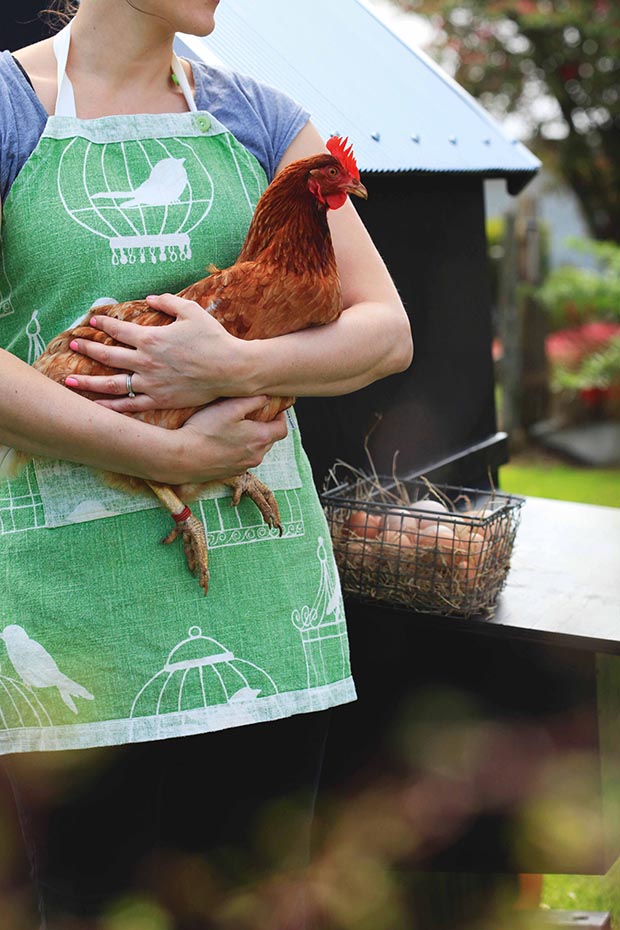
From a water-powered hen gate to a repurposed trampoline – ten inventive New Zealand chicken lovers share their best DIY coop designs.
Words: Nadene Hall
1. A converted playhouse in Whangarei
- The coop deck was built so their young sons could help.
- An old beer crate hung inside the coop holds feed out of reach of the birds.
- The chicken’s feeder.
- The flock love going under the coop on a hot day.
- “Sean was worried about rats (under the floor), but once he raised it up, they loved the space,” says Alana. “
Who: Alana Millington, with Sean, Jordan (7) and Carlo (2)
Where: Kamo, 7km north of Whangarei
Land: 4ha (10 acres)
Coop: converted playhouse, recycled timber
Flock: 6 (Bea, Boomer, Maxine, Ferguson, Vera, and Frankie, named after characters off the TV show Wentworth)
This is Alana Millington’s favourite place.
“It’s such a little special place for us, it’s the place I love the most. My partner proposed to me this year, the kids were there and he decided to ask me outside the chicken house, and I thought ‘oh my gosh, you couldn’t have picked a better place!’”
When the family moved onto their block, they inherited a beige-coloured playhouse and a shed of old paint tins. Builder Sean brought home offcuts of wood from his work, moved the playhouse to a good spot, raised it up on legs, added nest boxes and built a deck. They chose a nice red from their paint collection and the hen house was finished.
The hens are tame, raised by the family from chicks, and like her Wentworth namesake, Bea is the boss, leading the flock out to greet them each morning.
“Before we had these chickens, I would never be able to tell a chicken apart, but we know which is which, they’re like little people to us now, they’re so cute. We have a relationship you never thought you would ever have.”
2. A Taranaki enclosure
- The coop uses a stainless steel counterweight and a system of pulleys so you can open the internal door while outside.
- Council regulations mean the hens have to be completely contained.
- Andrew built 10 nesting boxes. A sliding door covers four of the 10 nests as they aren’t currently required, so the hens can’t dirty them up.
- The coop is easily accessible to children and adults, so it’s easy to clean.
Who: Andrew & Rachel Payne
Where: Stratford, 40km south of New Plymouth
Land: 1031m² (0.25 acre)
Flock: 6 hens (4 Hylines, 2 Orpingtons)
Construction: high quality timber, plywood, stainless steel fittings
Andrew Payne didn’t work from a plan when he built this coop in his family’s backyard – “I’m not very good at drawing, I just had to go ahead and do it” – but it still includes some thoughtful design ideas.
“We wanted something that would be a thing of beauty in the backyard. It makes it pleasurable for the girls – we have five girls, the oldest is 10, the youngest is just about two – for them to go out and clear the eggs, it’s a competition each morning.”
The Payne family lives on a large urban section and were subject to strict council rules regarding the placement of the coop. The logical spot was right on a boundary, but the council bylaws said it had to be at least 2m inside it. Andrew says fortunately they were willing to negotiate.
“Even 2m from the boundary can be quite disruptive, you then end up with all that unused, dead space. But they told us we could build up to the boundary so long as we got consent from the neighbour, so we had to go and get a letter and put that on the property file.”
This coop was definitely a labour of love, says Andrew.
“Not even factoring in my time, it probably cost about $2500 in materials, but it’s all high-quality materials, that coop is solid – it will be there in 50 years, I have no doubt in my mind. It’s got building paper in the roof, it’s all insulated roof, walls, everything.
“The eggs are a bonus for us. The girls love it, we’re getting some good eggs, we’ve got good chookies… that makes it all seem worthwhile.”
The coop is raised off the ground so there is maximum room for roaming.
“Primarily it was to buy more space, to maximise the use of that space, because where we’ve put the coop is between a shed and an undercover clothesline so we wanted to maximise use of space so as not to disrupt our backyard.
“They do actually go under there and dig out little ruts and bathe themselves in it. On really hot sunny days they’ve got that shade and shelter, or if it is raining they’ll be hunkering down under the chicken coop.”
3. A blue belle in Westport
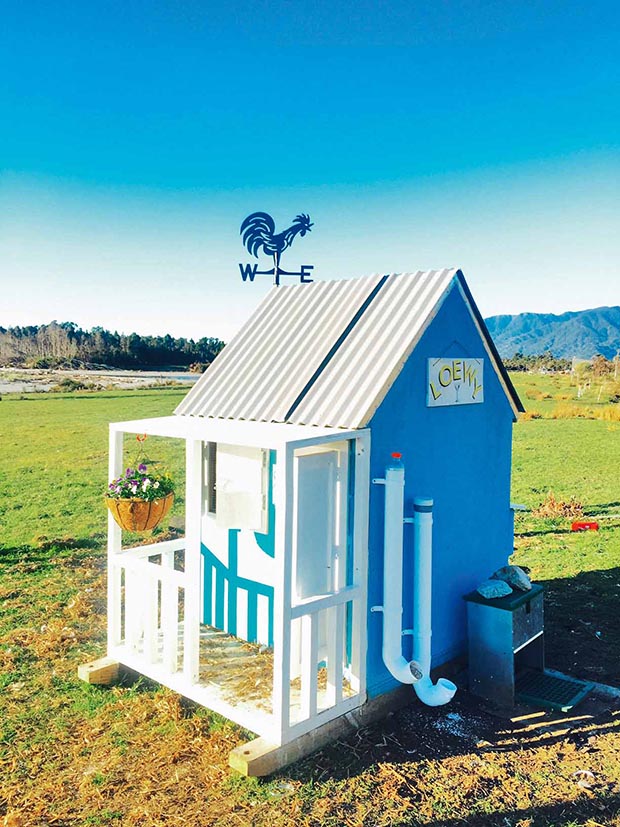
Name: Kelly Ginley
Where: Westport
Land: 8ha (21 acres)
Coop: Chook Manor Cottage Coop
Flock: 7 hens, 2 roosters (Orpington and Sussex), 2 Indian runner ducks
When Kelly Ginley lived in bustling Jakarta, the capital of Indonesia, she would often meet her girlfriends at a bar named Loewys*. These days, when she says she’s going to see the girls at Loewys, she’s heading out to her new coop to be with her flock on her family’s lifestyle block on the beach at Westport.
She’s still fairly new to poultry, only taking on the coop and her flock in the last few months.
“The chickens are named after all my friends (in Jakarta) where we were up until a year and a half ago. I ended up with two roosters. We had to change Tammy to Tommy and Sarah to Caitlyn, you know, after Bruce (Olympic decathlete champion Bruce Jenner who is now Caitlyn Jenner).”
Chook Manor’s Cottage Coop was a winner for its cute playhouse look, and Kelly painted it in her favourite colour, turquoise. She’s also made a few adjustments to take into account the massive amount of rain (6-8m a year) that falls on the West Coast, often horizontally. The coop now has shutters on the window, and the front door is three-quarters covered with plywood, leaving a chicken-sized gap at the bottom so that the rain can’t get in. Feed is kept in an automatic feeder (a Feed-o-matic), but Kelly also took inspiration from Pinterest and made some drainpipe feeders that her ducks seem to prefer feeding from.
Visiting her coop is the best part of her day, says Kelly.
“Collecting the eggs every morning, it’s like an Easter egg hunt every day. I take my basket out, I love it, I find it very relaxing having them. My husband thinks I’m nuts, but I just love having them.”
*named after Raymond Loewy, known as the ‘designer of the 20th century’, who created everything from Coca Cola’s iconic bottles to Greyhound buses, the logo for oil company Shell, and the paintwork on Airforce One.
4. From portaloo to chicken coop
- The hens love their unconventional coop.
Who: Justine Balcar
Where: Banks Peninsula, 50km south-east of Christchurch
Land: 4ha (10 acres)
Flock: 8 hens, 1 rooster
When you need a coop that’s easy-clean, plastic is the answer, and in Justine Balcar’s case, this is also the most innovative upcycling we’ve seen.
“I’d just helped my sister with a nasty infestation of red mite and really reading up found that plastic coops are good. I’d been given a couple of extra chickens from a friend who couldn’t keep them anymore and they were growing out of the wee coop I had, and I glanced across the paddock and thought, ‘that’s plastic.’”
The portable toilet had been deposited on their block by a flood before they moved onto the property. Once turned on its side, it turned out to be the perfect coop.
“They live in it, lay in it, hang out in it, they perch on the ventilation pipe at night. One insists on snuggling up in the urinal so I filled it with sawdust because I thought if she’s going to do that, that’s kind-of weird, but why not!
“You need two people to push it when you’re moving it around, it’s nice and weighted down. We just shut the ramp (door) up at night and put a bolt through the latch, so they’re nice and secure, no predators can get in – we’ve had a few stoats and rats and the odd thing which we’re trapping.”
5. A Taumarunui tramp bounces back to life
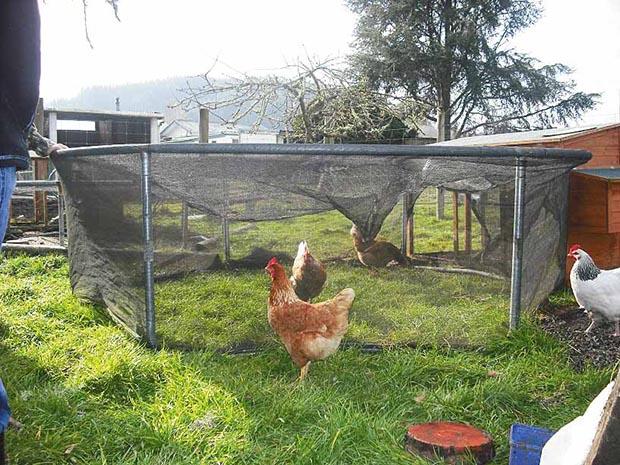
Who: Laura Herman
Where: Taumarunui
Land: 0.8ha (2 acres)
When trampolines die, you end up with the perfect, easy-to-move, easily assembled, solid frame for a run. Laura’s Dad helped her recycle the frames, and in one case the safety net as well after they ran out of netting.
6. Red mite-free in Ruakaka
- When John discovered he had an egg-eating hen, he created a contraption that lets the egg roll away from the hen.
- John’s roosting frame.
- The timer and bucket system.
- The door is closed until 11am.
- The timer opens the valve, allowing water to slowly fill the black bucket. It slowly falls, pulling the rope attached to the door.
- As it does, the door rises.
Who: John Kramer
Where: Ruakaka, 30km south of Whangarei
Land: 1.4ha
Flock: 10 Araucana/Black Orpington crosses, 1 bantam
If there’s one thing John Kramer doesn’t like, it’s red mites. His ingenious roosting system has kept his hens red mite-free for the last 18 months.
“It was horrendous, I went out there at night and the walls were just covered.”
After reading how red mite live on the coop, in cracks and joints within the timber framing, and then crawl out at night to feed off the hens as they sleep, he realised his roosts were giving the red mites a perfect pathway.
That’s where his independent, easily-removable roosting system comes into it. It sits inside the coop, slightly away from the walls. If a red mite wants to get to John’s hens, it has to travel down the wall, across the floor and up the pipe. It turns out, red mites don’t seem to be travellers.
“Since then I haven’t had a problem, and cleaning out the house is really easy.”
John has also discovered a way of re-purposing a common kitchen ingredient to fight scaly leg mite. “I go into the hutch at night and spray their legs with the cooking oil aerosol spray from my long-suffering wife’s kitchen. It seems to work.”
When John discovered he had an egg-eating hen, he turned to Bunnings. “I got a big paint tray, the biggest one you can get, they’re about $12, then I made up a frame with a lid. The chook lays their egg and it generally rolls away – I did have a piece of fabric so the egg would be hidden but mine didn’t seem to be too bothered.”
7. Permaculture power
- This coop could easily be mistaken for a garden shed.
Who: Kirsty Pascoe
Where: Auckland
Land: 450m²
Construction: timber framing, plywood, roofing iron
Chickens: 1 gold-laced Wyandotte, 1 lavender Araucana
This coop is on a small suburban section, but after a permaculture-based makeover of the garden – which now includes more than 60 varieties of fruit and berries, a large vegetable patch, beehives and two Manx cats – it’s a busy, productive place for Kirsty Pascoe.
This self-sufficiency advocate has two industrious helpers who are happy to work for free, and she says getting them was the best thing she ever did.
“I’ve been on the section a good 15 years, but I’ve only had chickens for the last three years. They were a therapy decision after I lost a significant person in my life, to keep me home and keep me grounded. I knew I would be developing the gardens so I wanted chooks to work the garden for me and to produce fertiliser, as well as eggs to supply me with food.”
The girls are locked up at night in their beautiful coop, but work during the day, turning over garden beds.
“I just put loads of manure and loads of food on the garden and they dig and scratch it all in for me. They’re just like a cat or a dog, but you get manure for the garden, and eggs. They’re a gardener’s friend.
“I didn’t realise how attached they get to you. As soon as they hear you moving in the house in the morning they are calling, the minute you step outside they come running, they’ll follow you all over the place like little dogs, they’re really social creatures.”
8. Water-gate chook motel in Mapua
- The chicken coop closed up for the night.
- One of Roger’s chickens heading outside to explore.
- The chickens let out to scratch around.
- Roger’s system uses a garden timer.
- It fills one bucket to open the door in the morning then another to close it at night.
- The system also refills the coop’s water trough.
Who: Roger Waddell
Where: Mapua, 30km north-west of Nelson
Land: 2.8ha (7 acres)
Web: www.thegates.co.nz
Flock: 8 hens, 3 Pekin ducks
Most hens lay their eggs in the morning, getting later in the day over 4-5 days until they take a day or two off, then start again with a morning egg. If you don’t want your hens running off to a hiding spot first thing to lay their eggs in a secret nest, it’s a good idea to keep them locked up until late morning so they have to use their coop.
But Roger Waddell’s job meant he couldn’t be home to let his flock out. He decided he’d make an automatic door opener, but he had a crucial limitation: no power source.
“Without having electricity I couldn’t use what a lot of people use – which is a car door window mechanism – so I had to use something that was not electrically-based.”
Roger turned to the laws of physics.
“I thought ‘I’ve got water, buckets, let’s make a lever system’ and it went from there.”
A cheap garden tap timer is connected to a hose. At the set time, the timer turns on the tap and water fills a bucket suspended off a rod. The rod pivots downwards with the bucket’s weight, lifting a door latch on the other end of the rod. Once the latch is lifted, the door falls open like a drawbridge.
The bucket has a tiny hole in its base so it slowly empties. This means Roger can use a second identical system working in reverse to close the door at night. An added bonus is that the buckets drain into a funnel and hose which fills up the chooks’ water trough.
“The only problem has been the occasional leaf getting in, the water can tend to grow a bit of algae, you have to periodically clean it out. I had to put waratahs around it because the sheep are nearby and they get curious, and on those days the chooks were lucky to get out early.
“It’s amazing how conditioned the chickens are now. Initially, they couldn’t understand it. Now, the moment they hear the water turn on they line up behind the door and 10-15 seconds later, they file out like they’re ‘Pavlov’s chooks’!”
9. A pallet paradise
- Every day or two, Raymond uses the scraper to clean out precious manure from the floor to add it to the garden for compost.
- The main door is slatted to keep it well ventilated and the birds can come and go via a small door at the bottom right.
- The wire mesh for the run was free, and the gate is an old pallet.
- A plastic box makes an easy-clean nest box.
- The pallet it sits on is angled so eggs naturally roll to the back of the box.
- The coop under construction.
- Raymond used temporary legs to hold it in place, then put a post on each corner to hold it.
Who: Raymond Eberhard
Where: Katikati, 35km north of Tauranga
Land: 1ha (2.5 acres)
Flock: 4 hens (Wyandottes, Langshans), Louis the rooster, Muscovy ducks
If you could walk around Raymond and Maureen Eberhard’s permaculture garden, you would immediately spot a theme: wooden pallets. They’ve been used to make the compost bin, gates, fencing, and this fabulous coop which is home to four hens and Louis the rooster. After almost 40 years of chicken ownership, Raymond is keen to encourage those who are new to poultry and on a budget to think about wood pallets.
“We love upcycling – we laughingly say I’ve progressed from general manager to general scavenger.
“We’ve always been keenly interested in organics and permaculture, and we’ve always had vegetable gardens, and the chooks are an integral part of that. There’s nothing better than collecting your own eggs.”
Raymond estimates this coop cost him about $50. His mission is to spread the word to new poultry owners that you don’t have to spend a lot to get a practical coop.
“The pallets we got for nothing. The paint we got on Trade Me. The hinges and the bolts to close the front door – op shops are a good source for those and garage sales are even better so for $2-3 you can get hinges and those galvanised bolts. The four posts that the coop is supported on (the legs), I bought those at a garage sale and they were the most expensive part. I think I paid about $15 for all four.
“The seller was an elderly man and he had heaps of stuff in his garden and when I told him it was a for chicken coop, there was a big tatty roll of fencing wire in the corner and he said ‘you can have that’… the perimeter wire of the whole run was free from that elderly man.”
RAYMOND’S 3 TIPS TO FINDING CHEAP (OR FREE) MATERIALS
1. Go to industrial parts of town
“The pallets we got for nothing and in case people don’t know, people who want to get rid of pallets pile them up on the side of the road. We always ask, but we know the regular spots, if you drive through an industrial or commercial area.”
2. Check the stamp
If a pallet has MB on it, avoid it, says Rayond. “If it’s stamped MB we don’t take that because that means it’s treated with methyl bromide. “But if it’s stamped HT, that stands for heat treated so we take those.”
3. Visit the cheapest hardware suppliers
Op shops are great places to find hinges, nuts, bolts and other types of fixings, but even better are garage sales says Raymond.
“We have the time to scrounge around and look for good materials. When you’re working that’s the problem, you just need a bit of time to do it this way, but for $50 approximately, that’s what we built and hopefully, it will inspire others if you don’t have a lot of cash to start up.”
10 A techno-coop in Lower Hutt
- Even the pretty door is functional. The Hilton sits on what can be a cold, damp spot, so Aaron double glazed the window to help keep the coop warm.
- Inside the main coop with its heating lamp in the ceiling.
- The ‘broody breaker’, a special nesting area where a broody hen has to sit for a couple of days on an old fridge shelf which lowers her body temperature and helps to stimulate laying.
- “ I wanted to raise some babies, but integrate them without too much drama and hen warfare so at the very end of the coop, we blocked it off, put a heat lamp in there, put up netting to separate them… we had no issues in socialising them whatsoever because they were all in the same space.”
- The waterers are connected to a garden timer and are flushed with fresh water twice a day. A scrunched ball of chicken wire acts as a filter
- “We use those bars over the outdoor one so they don’t stand in it because they’re pretty dumb, by putting that over it they don’t poop in it and because the water goes through two times a day, it flushes it and it keeps it pretty clean.”
Who: Tania & Aaron Hall
Where: Lower Hutt
Land: 823m²
Construction: plywood and timber, built within a small pool house
Chickens: 2 Orpingtons, 2 Leghorns, 2 Orpington crosses
Like any good hotel, the Hilton in Lower Hutt has individual rooms, a maternity wing, automatic doors, heating, and cold, fresh water on tap. This modern coop also has a webcam for security and its own server.
“If I’m out and about, at work, I can actually log on to our server and look at the webcam and show people the chickens!” says Tania Hall, laughing. “At first it was curiosity and also so we could live stream it to show to people, but because we shut the door at night from the laundry, we could check to see if they are all in before we shut the door.”
The designer and builder of all this technology is Tania’s husband Aaron – “He’s an electrician-Mr- Wonder-fix-everything sort-of a guy” – and like all his projects, he took the construction of the coop very seriously.
“You want to see the dog kennel, it’s got batts in it, it’s ridiculous, and double glazing in the windows,” says Tania. “He’s an active relaxer… and he’s a really clever guy, I think he’s secretly rather chuffed with it.”
The coop was originally a small pool house storing inflatable toys. Aaron used timber and plywood to build the coop within the existing structure and made it very functional. It includes five nesting boxes, a special broody box that doubles as a nest and a reptile heating lamp connected to a temperature sensor, which turns on when it goes below 10°C.
Aaron also ran a cable back to the laundry so they can shut the coop door at night without having to leave the house, and open it again the next morning.
By the time you read this, Tania, Aaron and their flock will be on their new lifestyle block in Shannon, starting their new venture, Shannon Organics. Tania has big plans for the Hilton 2. She and Aaron have already raised, killed, butchered and curried a rooster – “if we’re going to be farmers, we’ve got to get over it… it was quite an experience” – and she wants to breed heritage birds to sell to city-based enthusiasts.
The lessons she’s learned from running the Hilton will be incorporated into the new coop: a heat lamp, or an LED lamp running on solar power, lower roosts so the heavy breeds can safely jump down without the potential for hurting themselves, hinged roosts so they can be flipped up to make entry and cleaning easier, and a concrete floor for easy cleaning.
Love this story? Subscribe now!
 This article first appeared in NZ Lifestyle Block Magazine.
This article first appeared in NZ Lifestyle Block Magazine.
